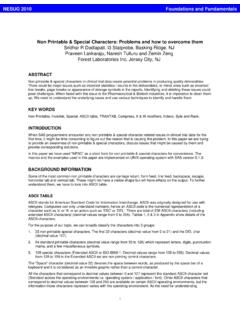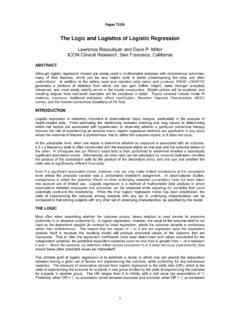Transcription of Don’t be afraid of PROC REPORT a step-by-step guide
1 PhUSE 2015. Paper IS08. Don't be afraid of PROC REPORT a step-by-step guide Nicola Tambascia, Accovion GmbH, Eschborn, Germany Konstanze Morgenroth, Accovion GmbH, Eschborn, Germany ABSTRACT. As a statistical programmer in the pharmaceutical industry you will come across PROC REPORT sooner or later during your daily work. When first looking at the structure of this powerful procedure you might be overwhelmed by the various options it offers. This paper will get you started with PROC REPORT and will help you to understand how to use the different options available to easily create the outputs you need. This paper is intended to provide a brief introduction to the SAS PROC REPORT procedure for beginners.
2 SAS . Version was used as basis for the content of this paper. SIMPLE PROC REPORT . PROC REPORT can be used to create a simple REPORT without having a deeper knowledge of the procedure. The basic structure of PROC REPORT is the following (a title was added by using the title statement before the PROC. REPORT ): title 'Simple REPORT ';. proc REPORT data = adsl;. run;. All variables of the selected dataset (in this example a minimized demography dataset was used) are listed. Submitting this simple statement, the output looks like this: SELECTING VARIABLES. As probably not all variables are required in the output, the next step should be to choose the variables to be displayed. This is easily done by adding the COLUMNS statement to the code: title 'Selecting variables'.
3 Proc REPORT data = adsl;. columns studyid usubjid agegrp sex race ethnic age;. run;. The output below shows that only the variables specified in the COLUMNS statement are displayed. Please note: the order in which you state the variables in the COLUMNS statement will determine the order of the variables in the output: 1. PhUSE 2015. DEFINING VARIABLES. Now that the required variables are selected, the appearance of the REPORT can be enhanced. This can be achieved by adding DEFINE statements to the code. PROC REPORT uses the variable labels (if not available, the variable names) as column headers for the output. The column headers can be adapted by using DEFINE statements as the following code shows: title 'Defining variables'.
4 Proc REPORT data = adsl;. columns studyid usubjid agegrp sex race ethnic age;. define studyid / 'Study ID';. define usubjid / 'Subject ID';. define agegrp / 'Age group';. define sex / 'Gender';. define race / 'Race';. define ethnic / 'Ethnicity';. define age / 'Age (Years)';. run;. The output now displays the labels defined above: The DEFINE statement offers more options that can be used to change the appearance of the output. The following ones are the most commonly used: DEFINE OPTIONS - WIDTH. As default PROC REPORT uses the variable length as column width for character variables and 8 for numeric variables, if the variable in the source dataset has no format assigned. In the previous output the column Study ID.
5 Was wider than needed, whereas the numeric Age column was smaller than needed (causing multiple line breaks in the column header). With the WIDTH option individual column widths can be specified for each variable. 2. PhUSE 2015. title 'Defining variable width';. proc REPORT data = adsl;. columns studyid usubjid agegrp sex race ethnic age;. define studyid / 'Study ID' width=10;. define usubjid / 'Subject ID';. define agegrp / 'Age group';. define sex / 'Gender';. define race / 'Race';. define ethnic / 'Ethnicity';. define age / 'Age (Years)' width=11;. run;. Submitting this statement, the output looks like this: DEFINE OPTIONS - format . The format option can be used to assign formats to the variables used in the PROC REPORT .
6 The formats used can either be SAS formats or a user-defined format . title 'Defining variable format ';. proc REPORT data = adsl;. columns studyid usubjid agegrp sex race ethnic age;. define studyid / 'Study ID' width=10;. define usubjid / 'Subject ID';. define agegrp / 'Age group';. define sex / 'Gender';. define race / 'Race';. define ethnic / 'Ethnicity';. define age / 'Age (Years)' width=11 format = ;. run;. The example below shows, how Age is displayed using the SAS format : DEFINE OPTIONS - SPACING. The SPACING option in the DEFINE statement specifies how many blank characters should be inserted between columns. The default is 2, but this can be increased or decreased to allow for better readability.
7 3. PhUSE 2015. title 'Defining spacing';. proc REPORT data = adsl;. columns studyid usubjid agegrp sex race ethnic age;. define studyid / 'Study ID' width=10;. define usubjid / 'Subject ID';. define agegrp / 'Age group' spacing=4;. define sex / 'Gender' spacing=4;. define race / 'Race';. define ethnic / 'Ethnicity';. define age / 'Age (Years)' width=11 format = ;. run;. Now there are 4 instead of previously 2 spaces between the columns: DEFINE OPTIONS - ORDER. The ORDER option can be used to order the rows in the REPORT according to their formatted values. The output will display only the first occurrence of the variable with the order option in a set of rows that have the same value for that order variable.
8 The default order is ascending, but this can be changed by adding the DESCENDING option to the DEFINE statement. title 'Defining data order';. proc REPORT data = adsl;. columns studyid usubjid agegrp sex race ethnic age;. define studyid / 'Study ID' width=10;. define usubjid / 'Subject ID';. define agegrp / 'Age group' spacing=4 order descending;. define sex / 'Gender' spacing=4;. define race / 'Race';. define ethnic / 'Ethnicity';. define age / 'Age (Years)' width=11 format = ;. run;. The output below displays the age group in a descending order and with grouped entries: The way the data is ordered can be influenced by specifying further details for the ORDER option. By using order=data descending values are displayed according to their order in the input data set, whereas order=formatted descending sorts the data by the formatted values.
9 Order=internal descending . 4. PhUSE 2015. would sort the data in the same way that PROC SORT would sort the data (be aware that this sorting may be platform dependent). For some statistics it is sometimes helpful to have a sorting variable that should actually not occur in the output. To achieve this the NOPRINT option can additionally be specified in the DEFINE statement of the sorting variable ( define sortvar / order=internal noprint ). DEFINE OPTIONS - JUSTIFICATION. To change the justification of the column entries LEFT, RIGHT or CENTER can be used in the DEFINE statement. title 'Defining data justification';. proc REPORT data = adsl;. columns studyid usubjid agegrp sex race ethnic age;. define studyid / 'Study ID' width=10.
10 Define usubjid / 'Subject ID';. define agegrp / 'Age group' spacing=4 order descending;. define sex / 'Gender' spacing=4 center;. define race / 'Race';. define ethnic / 'Ethnicity';. define age / 'Age (Years)' width=11 format = ;. run;. Submitting this statement, the entries of gender will be displayed centered: PROC REPORT LIST OPTION. Specifying all DEFINE statements for a larger output can be annoying and time consuming. Thanks to the LIST. option of PROC REPORT the effort needed for this can be reduced. The LIST option allows PROC REPORT to print all statements needed to produce the output into the Log window. Submitting the following code will generate a PROC REPORT with DEFINE statements for all variables in the dataset in the Log window: proc REPORT data = adsl LIST.













